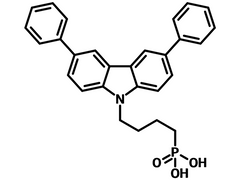Ph-4PACz
CAS Number 2814500-04-2
Charge Transport Layer Materials, Materials, Perovskite Interface Materials, Self-Assembled Monolayers (SAMs)Small Self-Assembled Monolayer Molecule for High Efficiency Perovskite Solar Cells
Ph-4PACz, Hole transport or extraction layer for p-i-n and large area perovskite solar cells, (4-(3,6-diphenyl-9H-carbazol-9-yl) butyl)phosphonic acid, CAS No. 2814500-04-2
Ph-4PACz, featuring a rotatory phenyl group, aims to enhance steric hindrance and diminish the intermolecular interactions between molecules. Compared to the well-known crystalline Me-4PACz, Ph-4PACz is amorphous, possessing a large dipole moment (2.32 D). The electron withdrawing phenyl groups reduce the electron density of the carbazole core and deepen the HOMO and Fermi level of Ph-4PACz compared to that of the Me-4PACz (with electron-donating methyl groups).
With high polarity, Ph-4PACz is designed to improve the band alignment and minimize the energy loss, demonstrating an open-circuit voltage (VOC) as high as 1.2 V for 1.55 eV perovskite. Alumina nanoparticles (Al2O3-NPs) can further smooth the interface between the Ph-4PACz self-assembled monolayer and the FTO substrate, leading to a conformal perovskite film with almost no voids in the buried interface. The smooth interface and conformal active layer film promote low exciton binding energy, fast hot-carrier extraction and low non-radiative recombination. Consequently, a large-area (1 cm2) device based on Ph-4PACz as the hole extraction layer gains a power conversion efficiency (PCE) of 24.61%.
Ph-4PACz works well for both small and large area devices. Serving as hole selective contact for organic solar cells and perovskite solar cells, Ph-4PACz is an alternative to PEDOT:PSS with superior performance and the convenience of solution deposition at low concentration, i.e. 1 mM.
Solution Processing Procedure
Typical processing solvents: Anhydrous ethanol (IPA, IPA/DMF are also superior solvents)
Typical concentration: 0.1 mM to 1 mM
Typical processing procedure: Ph-4PACz (0.1 mM in MeOH) solution is deposited onto the centre of the substrate surface and spin-coated for 30 s at the speed of 3000 rpm (DOI: 10.1002/aenm.202303941).
General Information
| CAS Number | 2814500-04-2 |
|---|---|
| Chemical Formula | C28H26NO3P |
| Molecular Weight | 455.48 g/mol |
| Absorption* | λmax (n.a.) |
| Fluorescence | λem (n.a.) |
| HOMO/LUMO | n.a. |
| Synonyms | (4-(3,6-Diphenyl-9H-carbazol-9-yl)butyl)phosphonic acid |
| Classification or Family | Carbazole derivatives, Self-assembly monolayers, Hole transport layer, Hole extraction layer, p-i-n Perovskite solar cells, Organic photovoltaics |
Product Details
| Purity | > 98% (HPLC) |
|---|---|
| Melting Point | Td = 364 °C (Thermogravimetric analysis) |
| Appearance | White to off-white powder |
Chemical Structure

MSDS Documentation
Literature and Reviews
- A, Sun et al. (2024); High Open-Circuit Voltage (1.197 V) in Large-Area (1 cm2) Inverted Perovskite Solar Cell via Interface Planarization and Highly Polar Self-Assembled Monolayer, Adv. Energy Mater., 14 (8), 2303941; DOI: 10.1002/aenm.202303941.
- X. Wang et al. (2024); Regulating phase homogeneity by self-assembled molecules for enhanced efficiency and stability of inverted perovskite solar cells, Nat. Photon., 18, 1269–1275; DOI: 10.1038/s41566-024-01531-x.
Licensed by Helmholtz-Zentrum Berlin für Materialien und Energie GmbH in Germany and Kaunas University of Technology in Lithuania.

 Ph-4PACz MSDS Sheet
Ph-4PACz MSDS Sheet